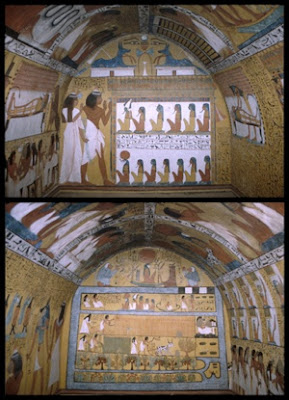
Egyptian art is commonly recognized by their stiff two-dimensional depictions of man. This has caused a somewhat unfavorable comparison to Greek styles. Although it is true that Egyptian art is less naturalistic, there is reason for this, every element in Egyptian art is meaningful. Artists of the era were accustomed to giving each element in a painting equal representation. Every piece in Egyptian art has a meaning and a reason for being included. They used scale and vertical placements to describe hierarchy and prominence in their culture.
A very salient subject in Egyptian art is the prospect of life after death. Many items were made to follow the deceased into the after life. For the wealthier individuals these items included jewelry, furniture, and other every day items that would be needed on the other side. Pictured left is an immaculately preserved interior of the tomb of Sennedjem, an artisan who lived during the reign of Rammsses II. The paintings covering the walls most likely represent the journey the deceased would take through the sprit world along with examples of activities the departed would like to continue to take part in in the afterlife.

A widely recognized and somewhat popularized symbol from ancient Egyptian art is the hieroglyph, ankh. There are mixed opinions on the origin of the ankh, a sexual symbol or a bow, but there is only one widely recognized meaning, life. On the right is a pillar of Pharaoh Senusret I holding two ankhs against his chest, possibly signifying eternal life. Other things to take note of is the positioning of the subject. Oftentimes in sculptures the left foot is put forward, almost giving the illusion of movement. Also, Pharaohs and other higher ranked individuals were sometimes represented with two left or two right hands and feet. This has been interpreted to signify whether the being was in a giving or receiving position from the Gods. What is interesting about this theory is that it has also been observed in Babylonian and Mesoamerican art.

Along side with humans, Egyptian artists relied heavily on the inclusion of Gods to tell stories and assist the dead in their passage through death. These Gods, often portrayed in anthropomorphic form, each held a purpose in the reality of the Egyptians. Each having a role in the weather, fertility, funerals, the sun, and many other aspects of human life. Seen is a depiction of five Gods. From left to right we have Anibus, the jackal headed protector of the dead. He is seen often in paintings depicting mummification. Next is Horus, a very familiar image known to serve the skies, hunting and war. Khnum, the ram-headed, protector of the sun God Ra. Mut, daughter of Ra, seen as a divine mother. And lastly we have Osiris the vegetation God, husband of Isis, and later ruler of the underworld. Each figure plays a significant role in any piece they are depicted in. They give each piece a deeper meaning.

Much like the Egyptian, the Greek also relied heavily on the representation of Gods. However, the Greek moved away from an anthropomorphic representation. Instead, Gods were presented as perfect humans. The Greek saw humans as natures highest creation, paying special attention to proportions and ratios. Instead of the static form and flatness we see in Egyptian pieces, Greeks focused on fluidity and naturalistic works of art. The artists were very much focused on anatomy and emotions and less about religion and symmetry.
Here in the "Statue of a Seated Boxer", we can plainly see the amount of detail given to the subject. This particular sculpture was cast in bronze around 300 BC. The Greeks art represented the very rigid gender lines between men and women during the time. The men were portrayed as strong, masculine, and powerful, where the women were seen as shy and sensual.
Much of the art that was made by the Greeks was used aesthetically. They decorated the homes of the wealthy and powerful. Other typical items include bowls and carafes that are painted to tell stories, much like the Egyptians.


Not only did the Greeks have very similar two dimensional drawing styles but they also involved Gods and Goddesses in their art.
Although the content of the stories differ, Greeks focused on philosophy over religion, it's plain to see the similarities in the execution. Here is a vase that depicts Poseidon handing over a piece of land, the island of Kos. This started a chain of events that later caused the Trojan war. On the right is a fresco depicting a soldier coming home after a battle. The wreaths, foliage, and pomegranates on the top resemble regeneration and glory.






